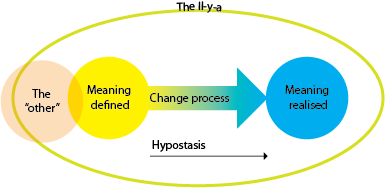Change with meaning: Levinas on the il-y-a, The Other, hypostasis, and a new representation
“Man’s search for meaning is the primary motivation in his life.” ~ Victor Frankl
The philosophy of Levinas seeks to expose the meaning behind change. Like seeing medical results that reflect poor life decisions, I question whether we are prepared for what we will see if we ask the question.

Photo credit: http://www.flickr.com/photos/40390680@N08/5446258724/
This is the third post in my research into change. My first post looked at why change has such a high failure rate and whether or not we are asking the right question. Post number two explored some of the challenges with linear approaches to change and whether they reflect reality. I now get philosophical as I dig deeper into questioning the meaning behind the change process.
To do this, I borrow on Naud Van der Ven and his application of the philosophy of Emmanuel Levinas to organisations in his book The Shame of Reason in Organizational Change.
Seeking escape from deception and blindness
Van der Ven’s premise is that change failure exposes managers to shame as they become aware of the challenges to their presumed rational model of change. This shame leads to two issues of deception and exclusion.
Deception comes into play when the model does not align with the irrational reality of the organisation. Managers and executives are portrayed as the height of rationality and the model is the tool to enforce that rationality. Whatever does not align with the model can be deceptively modified to keep up this portrayal, resulting in the model becoming more real than reality.
Exclusion occurs for whatever does not fit the model. Those who own the model are seen as experts closer to the truth, relegating external inputs such as disagreements to the model as data. This leads to a form of blindness called representationalism, where the very tools intended to aid in the cognitive processes act as inhibitors.
You cannot get rid of models, however. All of our thoughts are exposed to representational thinking as we stereotype and reduce our world into steps and boxes to make sense of the chaos. At the same time, people seek escape from the closure of a planned future and the constraints of artificial predefined structures.
Models are therefore inherently flawed but inevitable. If the issue is not the model, then what can be done to address perceived change failure rates?
Measuring change by meaning, not process

Van der Ven looks to Jewish philosopher Levinas to explore this question by taking concepts of the il-y-a, the Other, hypostasis and representation and applies them to the organisation.
Levnias speaks of the “il-y-a” as a formless void; a frightening neutrality devoid of meaning. Within organisations, the il-y-a is the meaninglessness and monotony of the institution. It is the mundane lack of purpose that is exposed when the stated profit motive is determined to be wholly unsatisfactory.
The il-y-a is exposed through engagement with what Levinas calls “the Other”, a presence separate, foreign and superior to the individual’s current state of being. In western culture, the Other is represented by the poor and unfortunate who reveal the futility of what is defined as progress. In organisations, the Other can be seen as the fringe, the disenchanted who search for more outside of the company profit mandate.
Once exposed to the il-y-a, individuals and organisations can go through a process Levinis calls hypostasis. This is a process of substantiation and awareness, naming things for what they are, developing consciousness and becoming a subject of the situation. The hypostasis process starts with stages of disgust, laziness, and fatigue in the first phase of “taking the distance” followed by stages of enjoyment, dwelling, labour, possession, and consciousness and representation in the second “separation” phase.
The individual expressing disgust with what is accepted by most as “meaning” are seen as repugnant by those blinded by taken-for-granted rationality. Management who are confronted with their own blindness feel shame. This shame can elicit one of two responses: protecting their reality through deception or exclusion as previously defined, or effecting change to take themselves through the stages of hypostasis. This process leads to new forms of representation and shifts – but never removes – the il-y-a.
Practical application… and why this may not work
The practical application of this would require the defining meaning and purpose behind the change. The measurement of the change process would not be so much whether the project was delivered against original scope, schedule, and budget parameters, as statistically you are looking at poor odds of a 30 percent success rate. Rather, the change would be measured by the extent to which the project achieved the meaning behind the change.
Being practical, applying meaning in organisation has three challenges:
First, Van der Ven’s material is not a light read. Models presented by other authors such as Kotter, Collins, and Peters are easily digestible step by step processes. In comparison, Van der Ven’s analysis requires more effort to understand and is less likely to be picked up by the lay manager looking for easy solutions that support his or her existing self-image of a controlled, rational leader.
Second, the philosophical model presents a challenge to core assumptions that may not be welcome. Linear models assume a rational approach that aligns with the profit motive of most organisations. Van der Ven’s philosophy does not negate profit as an outcome, but it does expose the potential lack of meaning inherent to an organisation defined around profit as a sole focus.
Third, linear models can be seen as telling managers to “do” differently, whereas philosophical models require managers to “be” different. Exposure to the frightening il-y-a can be threatening, despite sentiment that “man’s search for meaning is the primary motivation in his life”. The exposure of shame to the management elite is directly opposed to the reinforcement and glorification of successful execution of the linear model.
What to do with this
Does the il-y-ya exist? Is there a void just waiting for our introduction to the Other to expose the futility of what we thought was real?
A quest for meaning behind what we do requires a challenge to basic assumptions to which I suspect many are not prepared. Asking the question is akin to the parable of the emperor’s new clothes. I wonder if the premise is seen in Bill Maher’s commentary on Christmas commercialism. We see commercial expressions of change efforts, but are we right to ask “to what end?”
Statistically, our chances at successful change are pretty poor. Like going to the doctor, many search for the Other to help understand the meaning behind the change. If this meaning is defined and realised for both the individuals and the organisations involved, perhaps we could then redefine how we measure successful change.


good post Chad. keep digging… good thesis potential here.
Thank you Chad, for discussing our book. I think your three concluding observations/challenges are very much to the point. Fortunately I myself have the opportunity in my work to at least apply (if that’s not the wrong word indeed) something of the ideas of the book. And apart from that the workshop “Thinking for Someone Else” keeps me in dialogue with people about those ideas.